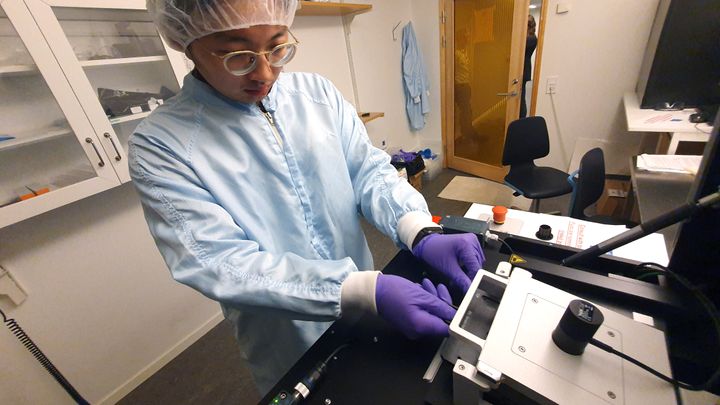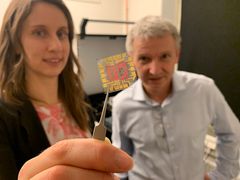Researchers hacked a 3D printer to speed up fabrication of bioelectronics
The speed of innovation in bioelectronics and critical sensors gets a new boost with the unveiling of a technique for fast-prototyping of devices.

A research team at KTH Royal Institute of Technology and Stockholm University reported a simple way to fabricate electrochemical transistors using a standard Nanoscribe 3D microprinter. Without cleanroom environments, solvents or chemicals, the researchers demonstrated that 3D microprinters can be hacked to laser print and micropattern semiconducting, conducting and insulating polymers.
Anna Herland , professor in Micro- and Nanosystems at KTH , says the printing of these polymers is a key step in prototyping new kinds of electrochemical transistors for medical implants, wearable electronics and biosensors.
The technique could replace time-consuming processes that require an expensive cleanroom environment. Nor would it involve solvents and developer baths that have a negative environmental impact, says the study’s co-author Erica Zeglio , a faculty researcher with Digital Futures , a research center jointly operated by KTH Royal Institute of Technology and Stockholm University.
“Current methods rely on expensive and unsustainable cleanroom practices,” Zeglio says. “The method we proposed here doesn’t.”
Polymers are core components of many bioelectronic and flexible electronic devices. The applications are diverse, including monitoring living tissues and cells and diagnosing diseases in point-of-care testing.
“Fast prototyping of these devices is time consuming and costly.” Herland says. “It hinders the widespread adoption of bioelectronic technologies.”
Using ultrafast laser pulses, the new method creates possibilities for the rapid prototyping and scaling of microscale devices for bioelectronics, says co-author and KTH Professor Frank Niklaus. The method could also be used for the patterning of other soft electronic devices, he says. The team applied the new method to fabricate complementary inverters and enzymatic glucose sensors.
Herland says the method could advance research in bioelectronic devices and significantly shorten the time-to-market.
“This also creates the possibility of replacing some of the current components with cheaper and more sustainable alternatives,” she says.
The researchers published their results in the journal Advanced Science.
Read the research paper
"Cleanroom-Free Direct Laser Micropatterning of Polymers for Organic Electrochemical Transistors in Logic Circuits and Glucose Biosensors", Advanced Science, https://doi.org/10.1002/advs.202307042
Images

Subscribe to releases from KTH Royal Institute of Technology
Subscribe to all the latest releases from KTH Royal Institute of Technology by registering your e-mail address below. You can unsubscribe at any time.
Latest releases from KTH Royal Institute of Technology
Study explains why new kinds of steel needed to build lead cooled reactors11.12.2025 14:23:59 CET | Press Release
Safer operation, better fuel efficiency and lower waste mark lead-cooled nuclear power as a potentially dramatic shift from the water-cooled nuclear stations the world has relied on since the mid 20th century. A recent Swedish study casts new light on how to avoid corrosion in the steel used to build these next-generation nuclear facilities.
Alternative to BPA passes toxicity and sustainability standards set by EU innovation guidelines4.12.2025 11:07:37 CET | Press Release
Polyester and a host of other plastic products could potentially be manufactured with non-toxic and sustainable BPA alternatives identified in a multidisciplinary study published today by researchers in Sweden.
Study shows potential for more affordable and efficient hydrogen gas production3.12.2025 15:29:35 CET | Press Release
A recent advance in the science of hydrogen fuel production could enable higher output and more sustainable production of this renewable energy source, researchers with Stockholm’s KTH Royal Institute of Technology report.
Calcium-sensitive switch designed to boost efficacy of cancer drugs24.11.2025 21:11:53 CET | Press Release
Cancer-fighting antibody drugs are designed to penetrate tumor cells and release a lethal payload deep within, but too often they don’t make it that far. A new study shows how this Trojan Horse strategy works better by exploiting calcium differences outside and inside cells.
Potential treatment may prevent brain damage in premature babies11.11.2025 11:10:46 CET | Press Release
A treatment that could protect premature babies from brain damage showed promise in a recent study in Sweden. Using a first-of-its-kind prenatal brain model created with human cells, researchers observed new details about the effects of cerebral hemorrhages on stem cells during premature birth. And they successfully tested an antidote that reduced the damage.
In our pressroom you can read all our latest releases, find our press contacts, images, documents and other relevant information about us.
Visit our pressroom